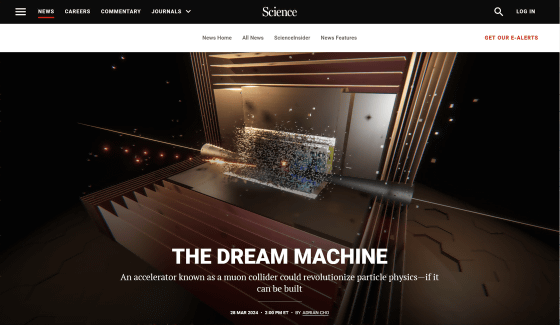Muon colliders, which can achieve higher collision energies than ever before, could revolutionize particle physics

In
A muon collider could revolutionize particle physics—if it can be built | Science | AAAS
https://www.science.org/content/article/muon-collider-could-revolutionize-particle-physics-if-it-can-be-built

For decades, particle physicists have used accelerators to collide high-energy particles and observe the resulting phenomena and particles. Because energy and mass are equivalent , colliding particles at high energies allows us to test the Standard Model , which describes the three fundamental interactions of elementary particles, and to search for unknown elementary particles and physical phenomena.
The most powerful accelerator in existence at the time of writing is the Large Hadron Collider (LHC) built by the European Organization for Nuclear Research (CERN) . The LHC is an accelerator that collides protons head-on as beams , and has been very active in contributing to the discovery of the theoretically predicted Higgs particle .
To understand even more elementary particles, it is necessary to collide particles with higher energies, so CERN is planning to build an even larger and more powerful accelerator. In contrast to the LHC, which is a 27 km long circular collider, CERN is considering a project to build the ' Future Circular Collider (FCC) ', which will be 100 km long.
CERN announces construction project for the world's largest particle accelerator with a total length of 100 km and a total construction cost of 3 trillion yen - GIGAZINE

However, the upgraded FCC (FCC-hh) may not be operational until 2070-2080, and many of the particle physicists conducting research at the time of writing are expected to be retired or dead by that time. Therefore, particle physicists, mainly in the United States, are promoting the development of a muon collider, which collides high-energy elementary particles called 'muons' rather than protons or electrons with antimuons .
In December 2023, the Particle Physics Project Prioritization Panel (5P), a scientific advisory committee for the US government, presented a research roadmap for the next 10 years in the US, calling for research and development of a muon collider. A muon collider could be small enough to fit on the campus of the Fermi National Accelerator Laboratory in the US, and if it can be built before Europe, the US will regain the lead in the accelerator development race.
The advantages of developing a muon collider include that it would be smaller and less expensive than a functionally equivalent proton collider, and could be completed decades sooner than FCC-hh. Muons are 207 times more massive than electrons and radiate much less energy during acceleration, so the radius of a circular accelerator would be only about 10 km. According to estimates, it would cost $50 billion to build an FCC-hh, while a muon collider with comparable performance could be built for $18 billion.
In addition, unlike protons, which are made up of multiple elementary particles, muons are elementary particles, so muon colliders are more likely to produce Higgs particles, which has been pointed out as an advantage in studying the Higgs field, which is important in particle physics research. 'We must not miss this opportunity. It is very important,' said Donatella Lucesi , a researcher at the Italian National Institute for Nuclear Physics.
Tova Holmes , a particle physicist at the University of Tennessee, said she expects the muon collider to be completed in about 25 years, because by the time FCC-hh is completed, she will surely be retired or dead. 'I don't mind a 10-year delay. It's much better than me being dead,' Holmes said.

While expectations for muon colliders are rising, it remains unclear whether a mechanism for accelerating and colliding muons can actually be realized. One of the major challenges is that, unlike protons and electrons, muons decay in just a fraction of a second.
Muons decay into neutrinos and antineutrinos in 2.2 microseconds if left alone, so the muon collider must create, accelerate, and collide muons in an instant. 'The challenge, in a word, is that muons are unstable,' said Sergo Zindariani , a particle physicist at Fermilab. 'So every step of the acceleration has to be incredibly fast.'
At the time of writing, the muon collider project has not yet begun, and particle physicists are still seeking support for basic research and development. Nevertheless, young researchers in particular seem to be fascinated by muon colliders, and Lucchesi commented, 'What's fascinating is not repeating something four or five times just to improve the error, but something completely new.'
Related Posts:
in Science, Posted by log1h_ik






